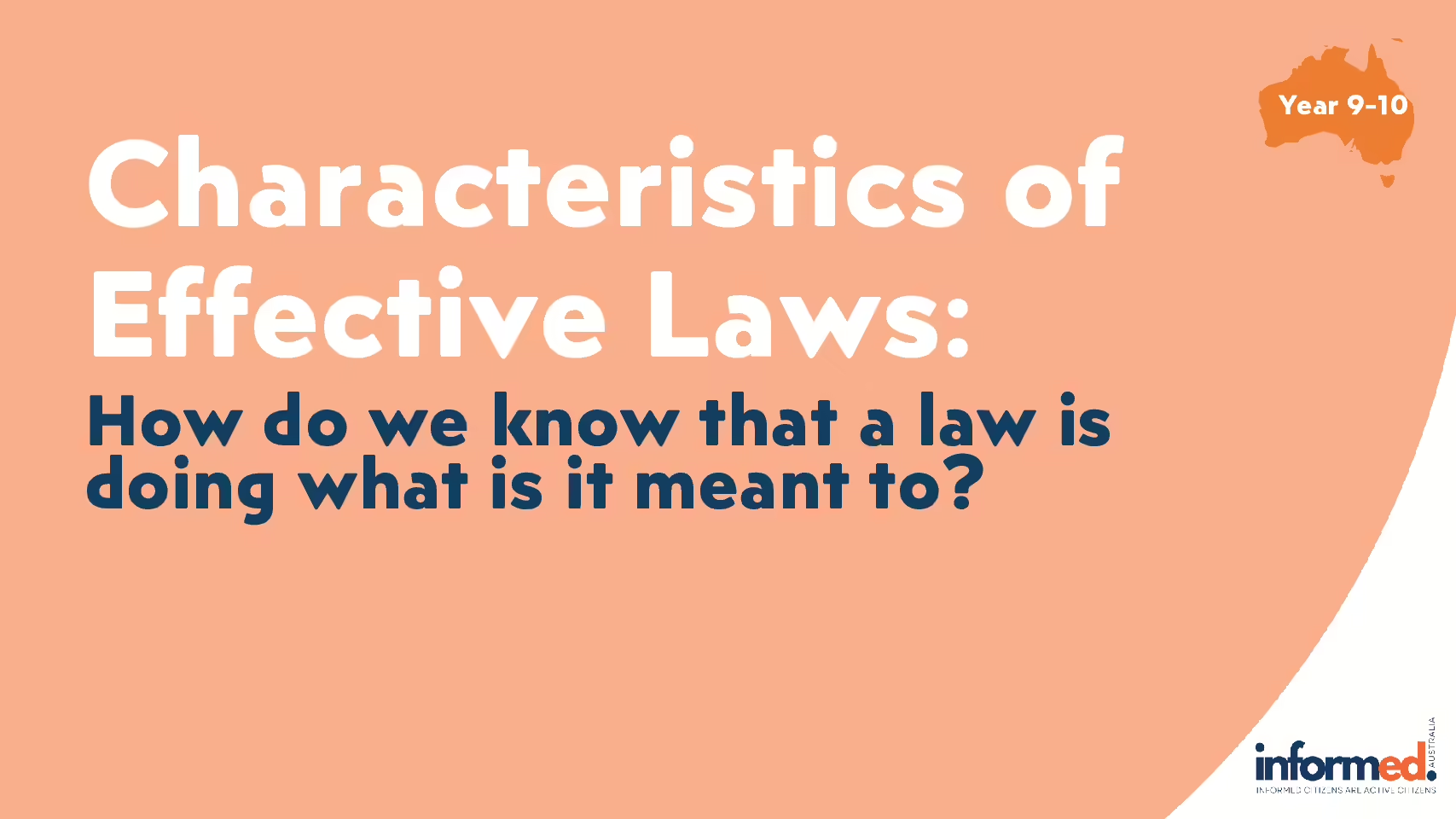Characteristics of Effective Laws
How do we know that a law is doing what is it meant to?

In Australia, Parliaments at Federal (Commonwealth) and State level, Legislative Assemblies at Territory level, and Local Governments at community level, have the responsibility to create laws to regulate behaviour to keep our community safe and functioning smoothly. As opposed to a dictatorship or authoritarian regime that is ruled by one person or group of people (rule by law), Australia is a representative democracy under the rule of law. This means that laws are made for the people by their democratically elected representatives, and everyone, including those in power, must follow the law and can only be punished for breaking a law in accordance with that particular law.
Key Characteristics of Effective Laws
The rule of law and human rights define the parameters of what makes a good law. Under the rule of law, effective laws are laws that can regulate the targeted behaviour in a way that is equal, fair and just, and protects the people from arbitrary rule.
1. The Law Protects the Rule of Law and Human Rights
Laws should reflect our systems of governance and not unreasonably erode rights, such as the presumption of innocence, fair and prompt trials, freedom of speech and equality before the law. They should also comply with Australia’s human rights obligations.
2. The law must be Clear
The law must clearly state what is expected for people to comply with it, and what penalties apply if they do not. Clearly defined laws help to prevent arbitrary rule and provide consistent decision making about breaches of law.
3. The law must be Known and Accessible
Law must be discoverable (easily found) by community members and use simple language (accessible) so it can be understood, increasing the ability of people to follow the law. The media can help with this by publicising laws or changes to laws.
4. The law must be Accepted
The community must accept the law as relevant and reflective of societies wishes and values, otherwise they may not follow it.
5. The law must be Applied Consistently and Fairly
The Executive authorities in charge of administering the law (applying it) and the Judiciary must be seen to be doing so in a way that is consistent, fair and equal. This means that everyone is subject to the law, even those in power, and that similar penalties are applied for similar breaches.
6. The law must be Enforceable
People breaking the law must be able to be brought to justice by relevant bodies of the Executive and the Judiciary. Without enforcement of penalties, there is no incentive for people to follow the law.
7. The law must be Stable
The law must not change regularly so the community knows what it required of them. This will enable people to comply with law and have trust in the legal system.
8. The law must be Amendable (Changeable)
As community needs and values change over time, the law must be able to change to ensure that the law is accepted, and people can follow it easily.
9. The law must be Prospective, not Retrospective
Retrospective Laws are laws passed today that change what was legal or illegal yesterday. This changes what people’s rights and responsibilities were in the past and makes people unable to comply with the law.
Examples:
The legal system has a principle that not knowing the law is not an excuse for not following it. However, there are many laws that people are unaware of or do not understand, making it difficult to follow them.
-
-
- Section 7A of the Summary Offences Act 1953 (SA), makes it illegal in South Australia to obstruct (disturb) a religious service, wedding or a funeral. This offence carries a fine of $10,000 or 2-years imprisonment.
- Under section 4 of the Summary Offences Act 1966 (Vic), flying a kite to the annoyance of another person carries a penalty of 5 penalty units (1 penalty unit = $197.59 at 1 July 2024).
- Section 21 of the Summary Offences Act 2005 (Qld) makes it illegal to publish a fake notice about a birth, death, marriage or funeral. The maximum penalty is 10 penalty units or six months imprisonment (1 penalty unit = $161.30 at July 1, 2024).
-


